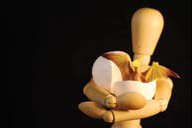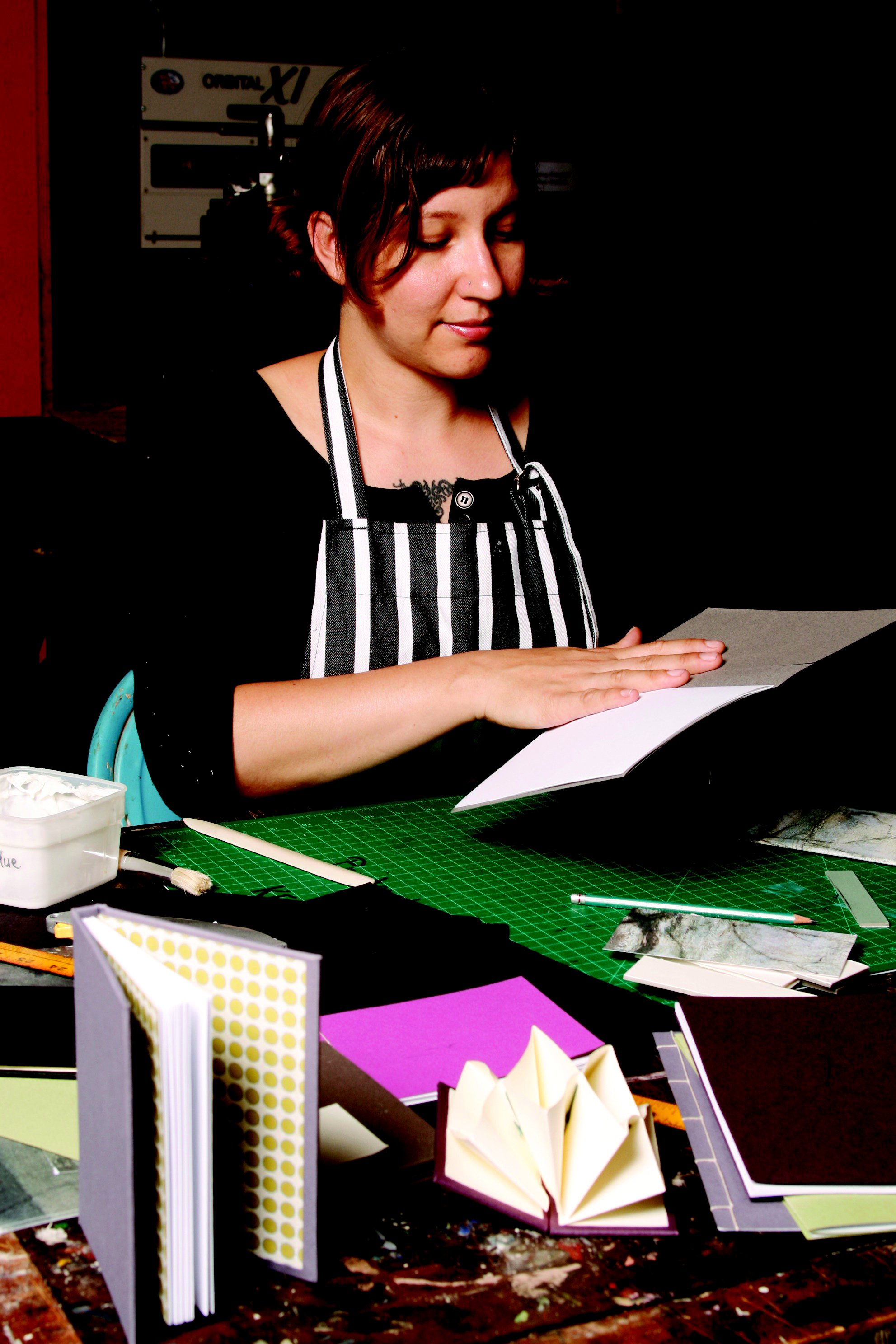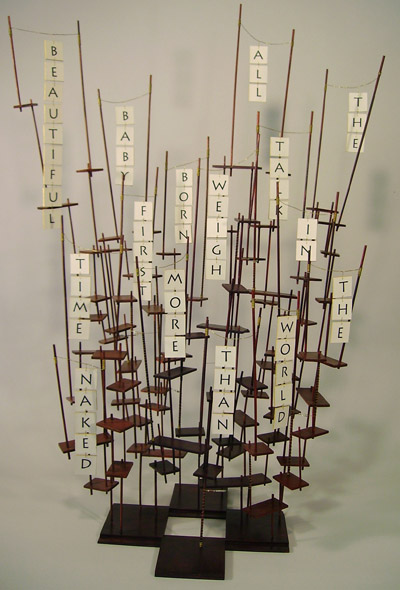2007–2008 Exhibitions
Annual Juried Student Art Exhibition
Potluck dinner and reception was 5-7 p.m. Monday, May 21 in the University Art Gallery courtyard, Art and Education Building, 25800 Carlos Bee Blvd., Hayward.
Exhibit was open 2:30-3:30 p.m. Monday-Thursday through June 7 (except Memorial Day, May 28). Admission was free.
Kerri Johnson, director of the Oakland Art Gallery and curator of Blankspace Gallery, is judging this year’s exhibit entries.
The exhibit pieces will be eligible for various awards, including:
Cash awards: Toki Ceramic: $500 and $200; Mixed Media: $400, and two $200; Slatoff Trust: two $500 (one traditional art, one electronic); San Leandro Art Association Scholarship: $700 to a current Art major with financial need and who is returning in the fall; Mona Froyland Memorial: $500; Hayward Arts Council Awards: three of $200 each (pictorial, spatial and photo/new media); Friends of the Arts Award: $400; University Art Center: $250; Utrecht Art Supplies: $75; Blick Art Materials: $50; Henri Cartier Bresson: $50 (photo); and Imogen Cunningham: $50 (photo).
Gift certificates will be given from True Value Hardware to a ceramics student; Ritz Camera to a photography student; and from the Pioneer Bookstore. There also will be a portfolio contest for a $300 award, separate from the juried show.
American Prints & Modern Books
Opening May 20, 5-7 p.m.
Shown simultaneously in the satellite gallery at the back of the facilities was "American Prints and Modern Books," a group of prints donated by Bay Area collector Roy Kahn.
Cutting Edge Books
Student Books
Oct. 22-Nov. 29 (except Nov. 22)
Opening reception: Oct. 22, 5-7 p.m.
Exhibits: M-Th 12:30-3:30 p.m.
Free
“Cutting Edge Books,” a juried exhibition by artist members of Pacific Center for the Book Arts (PCBA) and “Student Books,” a companion show by 11 Cal State East Bay art students and alumni, will share the University Art Gallery beginning Oct. 22.
The professional show includes the work of 31 artists that goes beyond traditional books to include pages unencumbered by binding, nontraditional materials, free form shapes and interactive media.
The creators are both professionals and emerging artists from California, Arizona, Massachusetts, Pennsylvania and Australia. Curators are Michael Henninger, CSUEB associate professor of art, and Tanya Wilkinson and Priscilla Otani of PCBA.
Participating artists are Jody Alexander, Alice Austin, Tania Baban, Lark Burkhart, Diane Cassidy, Sas Colby, Steven Daiber, Betsy Davids, Reiko Fujii, Alisa Golden, CJ Grossman, Charles Hobson, Wendy Jordan, Deborah Kogan, Jim Machacek, Helen Malone, Victoria May, Barbara Milman, Zea Morvitz, Dorothy Nissen, Priscilla Otani, Bettina Pauly, Kathryn Pinto, Lynne Prather, Johanna Rogers, Christine Rolik, Elizabeth Sher, Tess Sinclair, Ellie Wilder, Tanya Wilkinson and Dorothy Yule.
“Student Book Art,” a collection of 12 pieces by Cal State East Bay art students and alumni, utilizes a range of book structures from simple pamphlets, to accordion folds, to scrolls, to unique bindings of the student’s own devising. Participating students are Matt Breault, Cherie Johnson and Michael Wallace; the alumni are Antonio Arribas-Mena, J. Campbell, Conrado Cruz, Robin Gotfrid, Patrick Ho, Jennifer Long, Angelo Martinez and Derek Wilson.
The pieces come from two classes, Art 4210 - Computers & Printmaking, a required course of Graphic Design majors, and Art 1121 - Intro to Bookmaking, which launched in Winter, 2007.
The combined exhibit will open with a reception from 5-7 p.m. Oct. 22 in the University Art Gallery, 25800 Carlos Bee Blvd., Hayward, and will feature discussions by several of the participating artists.
The shows continue Monday-Thursday through Nov. 29 (except Nov. 22) from 12:30-3:30 p.m. Admission is free to both the exhibits and opening.
Welcome to the "Spirit of the Renaissance: A recreation of the Urbino Studiolo Around 1500"
When most art historians use the word “modern” their reference is to a period between the middle of the 19th century and the middle of the 20th century. However, when social historians and cultural historians use the word “modern” they have a much larger frame of reference. They usually mean from the Renaissance to the 20th century, in other words, from the time when the ideals of the Middle Ages were replaced by those that most of modern people still live by artistically, socially, economically, and spiritually. When did the Renaissance begin? Literary historians usually say in the 14th century. Art historians usually say in the 15th century.
Italy in the 15th century was a patchwork of independent city-states. Among the most highly developed cultural centers in northern Italy were Florence, Sienna, Venice, Milan, Mantua, and Urbino. Urbino is the city that remains most like it was five centuries ago. The rulers of these centers had to deal with many problems: economic. military, etc. But most of them also were humanists. Inspired by the Greeks and Romans, they wanted the artists they patronized to harmonize Christian ideals with the ideals of the ancients. When the Dukes & Duchesses of these little nations wanted to get away from it all and read quietly or meditate on Platonic harmonies, they often did so in a small chamber called a studiolo. Here were housed their libraries and the finest of their paintings, sculptures, and other objects of "vertu" - objects of exceptional character, which stimulated them to be persons of exceptional character.
Frederico da Montefeltro, Duke of Urbino (1422-82), was an exceptional character. In between fighting the wars that kept his people safe, his legendary patronage extended to some of the greatest painters, architects, and philosophers of the age, figures such as Piero, Alberti, and Pacioli. Thanks to a book by Castiglione about life there, the court of Urbino was known throughout Europe as a place that understood the true meaning of artistic, social, and spiritual "vertu". From this world came the profoundly beautiful art and architecture of Raphael and Bramante. We know more about the Urbino studiolo than we do about any other. That special space is our point-of-departure for this exhibition in which we suspend disbelief and pretend we are visiting the Duke’s little treasure chest of art and ideas. The size of our gallery is about the same as that of the original studiolo.
This exhibition is the first in a new series of small teaching exhibitions designed as experiential adjuncts to various Art History and Studio courses. The Satellite Gallery this time is a “display case ”inside of which our students can see not slides but original objects and facsimiles of objects created in Italy and northern Europe between the 14th & 16th centuries. Future exhibitions could be devoted to such themes as Shamanic Objects, Asian Sculpture, the Civil Rights Movement, and Postmodernism.
—Lanier Graham, Director, University Art Gallery, CSUEB


